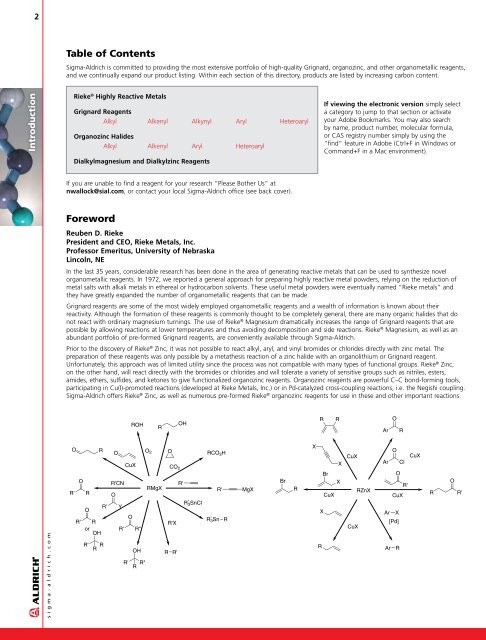Grignard and Organozinc Reagents - Sigma-Aldrich
Grignard and Organozinc Reagents - Sigma-Aldrich
Grignard and Organozinc Reagents - Sigma-Aldrich
You also want an ePaper? Increase the reach of your titles
YUMPU automatically turns print PDFs into web optimized ePapers that Google loves.
Introduction<br />
s i g m a - a l d r i c h . c o m<br />
Table of Contents<br />
<strong>Sigma</strong>-<strong>Aldrich</strong> is committed to providing the most extensive portfolio of high-quality <strong>Grignard</strong>, organozinc, <strong>and</strong> other organometallic reagents,<br />
<strong>and</strong> we continually exp<strong>and</strong> our product listing. Within each section of this directory, products are listed by increasing carbon content.<br />
Rieke ® Highly Reactive Metals<br />
<strong>Grignard</strong> <strong>Reagents</strong><br />
Alkyl Alkenyl Alkynyl Aryl Heteroaryl<br />
<strong>Organozinc</strong> Halides<br />
Alkyl Alkenyl Aryl Heteroaryl<br />
Dialkylmagnesium <strong>and</strong> Dialkylzinc <strong>Reagents</strong><br />
If you are unable to find a reagent for your research “Please Bother Us” at<br />
nwallock@sial.com, or contact your local <strong>Sigma</strong>-<strong>Aldrich</strong> office (see back cover).<br />
Foreword<br />
Reuben D. Rieke<br />
President <strong>and</strong> CEO, Rieke Metals, Inc.<br />
Professor Emeritus, University of Nebraska<br />
Lincoln, NE<br />
In the last 35 years, considerable research has been done in the area of generating reactive metals that can be used to synthesize novel<br />
organometallic reagents. In 1972, we reported a general approach for preparing highly reactive metal powders, relying on the reduction of<br />
metal salts with alkali metals in ethereal or hydrocarbon solvents. These useful metal powders were eventually named “Rieke metals” <strong>and</strong><br />
they have greatly exp<strong>and</strong>ed the number of organometallic reagents that can be made.<br />
<strong>Grignard</strong> reagents are some of the most widely employed organometallic reagents <strong>and</strong> a wealth of information is known about their<br />
reactivity. Although the formation of these reagents is commonly thought to be completely general, there are many organic halides that do<br />
not react with ordinary magnesium turnings. The use of Rieke ® Magnesium dramatically increases the range of <strong>Grignard</strong> reagents that are<br />
possible by allowing reactions at lower temperatures <strong>and</strong> thus avoiding decomposition <strong>and</strong> side reactions. Rieke ® Magnesium, as well as an<br />
abundant portfolio of pre-formed <strong>Grignard</strong> reagents, are conveniently available through <strong>Sigma</strong>-<strong>Aldrich</strong>.<br />
Prior to the discovery of Rieke ® Zinc, it was not possible to react alkyl, aryl, <strong>and</strong> vinyl bromides or chlorides directly with zinc metal. The<br />
preparation of these reagents was only possible by a metathesis reaction of a zinc halide with an organolithium or <strong>Grignard</strong> reagent.<br />
Unfortunately, this approach was of limited utility since the process was not compatible with many types of functional groups. Rieke ® Zinc,<br />
on the other h<strong>and</strong>, will react directly with the bromides or chlorides <strong>and</strong> will tolerate a variety of sensitive groups such as nitriles, esters,<br />
amides, ethers, sulfides, <strong>and</strong> ketones to give functionalized organozinc reagents. <strong>Organozinc</strong> reagents are powerful C–C bond-forming tools,<br />
participating in Cu(I)-promoted reactions (developed at Rieke Metals, Inc.) or in Pd-catalyzed cross-coupling reactions, i.e. the Negishi coupling.<br />
<strong>Sigma</strong>-<strong>Aldrich</strong> offers Rieke ® Zinc, as well as numerous pre-formed Rieke ® organozinc reagents for use in these <strong>and</strong> other important reactions.<br />
O R<br />
O<br />
R' R<br />
O<br />
R' R<br />
or<br />
OH<br />
R' R<br />
R<br />
O<br />
O<br />
R'CN<br />
R' Y<br />
CuX<br />
O<br />
ROH<br />
R' R"<br />
OH<br />
R' R"<br />
R<br />
O2<br />
R<br />
O<br />
CO2<br />
RCO2H<br />
R'<br />
RMgX R' MgX<br />
R'X<br />
R R'<br />
OH<br />
R3SnCl '<br />
R3Sn ' R<br />
Br<br />
R<br />
X<br />
R<br />
X<br />
R<br />
If viewing the electronic version simply select<br />
a category to jump to that section or activate<br />
your Adobe Bookmarks. You may also search<br />
by name, product number, molecular formula,<br />
or CAS registry number simply by using the<br />
“find” feature in Adobe (Ctrl+F in Windows or<br />
Comm<strong>and</strong>+F in a Mac environment).<br />
Br<br />
CuX<br />
R<br />
X<br />
X<br />
CuX<br />
CuX<br />
RZnX<br />
O<br />
Ar R<br />
O<br />
Ar Cl<br />
O<br />
CuX<br />
Ar X<br />
[Pd]<br />
Ar R<br />
R'<br />
CuX<br />
R<br />
O<br />
R'

















